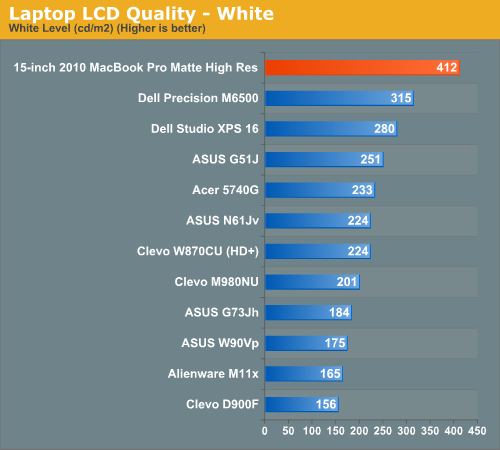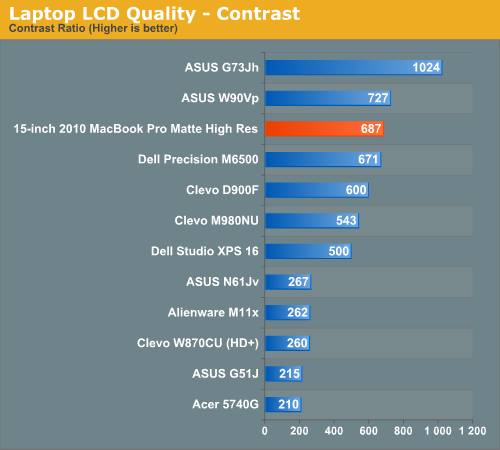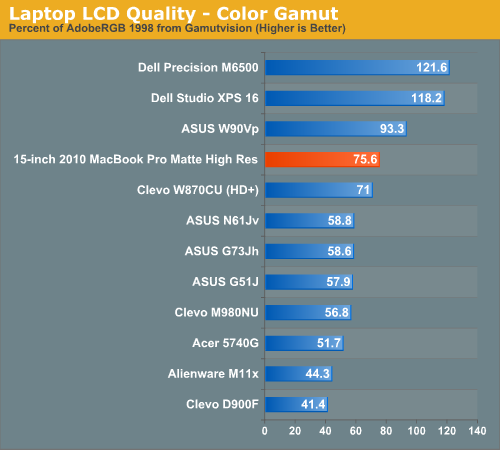Apple's 15-inch 2010 MacBook Pro: More Battery Life Tests, High Res Display Evaluated
by Anand Lal Shimpi on April 24, 2010 1:57 AM EST- Posted in
- Mac
- Displays
- MacBook Pro
- Arrandale
- Laptops
High Resolution, Matte Display: Tested
For creative professionals and digital photography or videography enthusiasts alike, LCD quality of the MacBook Pro is a huge consideration. Luckily, Apple delivers in this department.
Apple thankfully provides matte high resolution display options for both the 15” and 17” MacBook Pros. If you’re partial to glossy displays, there’s also a glossy high resolution display option available online, though it isn’t one of the SKUs that will be stocked in Apple retail stores - you’ll have to order it online.
Since many creative professionals likely will seek the matte option (and because it’s the only high resolution display option available in-store), we chose to do monitor profiling and analysis with this particular model. On the surface, very little has changed, the display itself still substitutes the black glass bezel for an aluminum one. The LCD sits inset from the aluminum bezel about a millimeter, diminishing the chances of your keyboard smudging and scratching up the display like what was so endemic with the pre-unibody design.
| 15-inch 2010 MacBook Pro 6,2 Core i7 | |||
|
Matte High Resolution Display Option
|
|||
| Panel Type | TN (Samsung LTN154MT07) | ||
| Pixel Pitch | 0.197mm | ||
| Viewable Size | 15.4 diagonal | ||
| Resolution | 1680 x 1050 (WSXGA+) | ||
| Screen Treatment | Matte (anti-glare) | ||
The first thing that strikes you about the 2010 MacBook Pro LCD is how bright it is. As we’ll show in a minute, it’s the brightest LCD we’ve tested, thanks in part to its WLED backlighting. While the color gamut is only above average, Delta E tracking is also very good.
For these tests, we used ColorEyes Display Pro with an X-Rite Eye-One Display 2 colorimeter. I originally tested at maximum brightness, and then at precisely 200 nits of luminance. The black level down below is given at maximum brightness. Interestingly enough, Delta E tracking and color accuracy remains largely the same at both settings.
Another note I’ll leave you with is that although using a calibration tool is still an absolute must for the best monitor performance, Apple’s display profile that ships with OS X is surprisingly good. Out of box, the display’s white point was almost exactly 6500K, and the LUT curves subjectively nearly matched those that eventually resulted after calibration. Color tracking and Delta E weren’t good, but subjectively the display looked good.





The LED backlight Apple uses in the display still isn’t RGB LED, so color gamut isn’t anything spectacular, but it isn’t bad either. Performance is average, but what we get is both expected and pretty good for this class of LED backlit notebook displays.


Display uniformity is very good; there is virtually no distracting light leakage from any of the displays. In addition, black level is very good throughout. The viewing angles remain largely what you’d expect from any TN panel in its class. There isn’t an overwhelming amount of color shift when viewing the monitor at horizontal angles. Vertical is another story - there’s a tight range of vertical angles over which the color shift is negligible.
The performance we get with the MacBook Pro’s display is very good - but it still could be better. Among WLED backlit, TN packing notebook LCDs, it certainly shines out as one of the best options. That said, there’s no reason this “Pro” notebook shouldn’t see RGB LED backlighting and potentially even an IPS panel as options soon. Enthusiasts and professionals are more than willing to shell out the cash for large gamut LCDs on the desktop - why not on the notebook? It’s obvious that Apple isn’t averse to IPS panels, especially considering the iPad.
















69 Comments
View All Comments
Anand Lal Shimpi - Saturday, April 24, 2010 - link
Thank you!Take care,
Anand
BanditWorks - Saturday, April 24, 2010 - link
I don't have the new MacBook Pros, but I do have a year old regular MacBook and while I was giving the new Adobe Flash 10.1 beta (the one that utilizes the GPU and CPU) I definitely saw a noticeable difference in battery life.As I wasn't doing anything that intensive on my MacBook I went back to the most stable version of Flash and it felt as if I had installed a newer, longer lasting battery instantaneously.
PS - Yeah, glossy screens suck big time. They're as tacky as a car with everything chromed out. They may be nice to look at when the screen is turned off, but for everything else they don't really serve much of a purpose in my opinion.
Computer Scooter Joe - Saturday, April 24, 2010 - link
Anand,You mentioned under windows the dGPU will always be on. In regards to this i have two questions:
1) Are there any heat issues with the dGPU being on all the time? Does the laptop get especially hot?
2) Do you foresee being able to enable graphics switching under windows? (Be it via Apple or a hack/3rd-party program)
I'm going to be attending University in the fall and i really like the aesthetics of the Macbook Pros; but these two questions have me a little worried. Having tried it, I must admit, I really do not like OSX at all (yes i know, blasphemy and all that), and i plan on bootcamping Windows 7. Price is not an issue; performance (or lack thereof) is what matters.
PS: To other commenters, please do not flame and start saying "Go buy Laptop X from this other company, Mac's are overpriced."
Thanks in advance.
Brian Klug - Saturday, April 24, 2010 - link
I can't speak entirely for the dGPU temperature in Windows 7 or boot camp installed OSes, but I do think I can talk a little about the dGPU temperature because I find myself switched on it a lot for what I do.I run a lot of Matlab related software on OS X (as I'm also a student), which requires an X11 instance. It seems that the X11 window system on OS X inevitably calls one of those core libraries that triggers the discrete GPU switching, and usually I don't notice until a good hour or so later that I'm on the dGPU. You'll notice that the battery life estimate changes. It doesn't immediately dramatically suffer, but it just seems shorter. Temperature creeps up a bit, but in practice for what I'm doing being switched on the dGPU doesn't raise internal temperatures more than 15 degrees F. I'd imagine playing games or doing some heavy OpenGL loads would change that though.
Apple has done a pretty good job with the thermal management from what I've seen thus far. I've had a couple of eyebrow-raising moments burning in the matte MBP I used for the display review section, but it's important to understand that temps up to 200F (while admittedly INSANE IMO) are well within the T_junction spec from the i7 spec sheet. The CPU will throttle long before you do any physical damage.
-Brian Klug
solipsism - Saturday, April 24, 2010 - link
Thanks for the review.I know that there is a Sys Pref option to keep the dGPU on all the time, but there is no power saving option to disable the dGPU completely. Did you find a secret switch, like in an PLIST file that will allow this to happen. This would come in handy for long bouts without a power cord attached.
etikka - Saturday, April 24, 2010 - link
Hi,Thank you for the review.
It would be great to have a review on the Macbookish HP envy 15". The looks are ok and it would be great to have a quad core CPU and working GPU switching under Win7.
MySchizoBuddy - Saturday, April 24, 2010 - link
offtopicSo Matlab is still using X11 on Mac OS X. I think they were working on a mac native version I guess they haven't released it yet
Brian Klug - Saturday, April 24, 2010 - link
See I agree completely! There needs to be a native version already. I haven't investigated it a lot, but it could be related to the 64-bit version I'm running. I'm on 2010a.I did some reading a while ago and the consensus was that Matlab on OS X just runs a LOT slower. Almost twice as slow in some cases. It isn't so much a problem stemming from the X11 window session rendering pipeline, but the java swing rendering pipeline. I'm puzzled why the platform is getting so little attention from the Mathworks when I see a huge population of students with exclusive mac setups. Oh well.
There's an awesome (bit dated though) thread here: http://www.macresearch.org/matlab-and-os-x
-Brian
ken.atwell - Friday, May 7, 2010 - link
I work for The MathWorks and a little while back I blogged about MATLAB on the Mac, including MATLAB's (diminishing) dependency on X11 . The performance of MATLAB on the Mac platform is also discussed, though you need to dig into the comments a bit (comment #12). If you are interested in these topics, you may want to visit:http://blogs.mathworks.com/desktop/2009/08/31/poun...
Ken Atwell
damianrobertjones - Saturday, April 24, 2010 - link
Thank you for the info, but, when are you going to review or run ANY articles with regards to the new Fujitsu, HP and Toshiba i7/i5 Tablets which are brand new and just out......Why don't they/haven't they been mentioned at all?